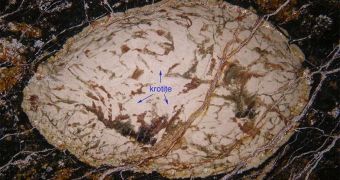A team of investigators announces the discovery of a new mineral in an ancient meteorite, which was most likely formed when the solar system was in its earliest days. The new material is very peculiar, and it needs special conditions in order to form.
Experts discovered it while analyzing the carbonaceous chondrite called NWA 1934 CV3. The object is a member of a special class of space rocks, that are believed to have began forming at the same time the planets and moons of the solar system did.
NWA 1934 CV3 itself is estimated to be around 4.5 billion years old, which means that it condensed from the same solar nebula that eventually formed all the planets, moons and space rocks we see today.
Researchers dubbed the new material krotite, and determined that it needs temperatures exceeding 1,500 degrees Celsius (2,732 degrees Fahrenheit) to form. In essence, it is a compound of oxygen, aluminum and calcium, Space reports.
The reason why studying these ancient chondrites is so important is because they can provide us with a deeper understanding of what went on as the protoplanetary disk around the newly-formed Sun began to differentiate itself into all the components we see today.
Sometimes, all that is needed to clear such a large mystery is a piece of material just 4 millimeters (0.2 inches) long. It was discovered in a “cracked egg” structure inside the space rock, alongside 8 other minerals. One of them is entirely new to science.
“This meteorite likely came from an asteroid in the asteroid belt,” explains the leader of the new research, California Institute of Technology (Caltech) expert Chi Ma. He adds that the mineral was most likely one of the first to form in the early solar system.
In a new paper describing the findings, published in the May-June issue of the esteemed journal American Mineralogist, Chi Ma adds that the new mineral was named in honor of University of Hawaii cosmochemist Alexander N. Krot.
The expert made significant contributions to understanding the earliest days of the solar system through chemical analysis of meteorites and other space rocks, and this is how his work is recognized as vitally important to this field of research.

 14 DAY TRIAL //
14 DAY TRIAL //